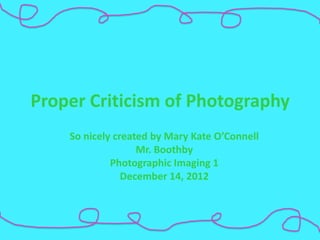
How to Properly Critique a Photograph
- 1. Proper Criticism of Photography So nicely created by Mary Kate O’Connell Mr. Boothby Photographic Imaging 1 December 14, 2012
- 2. “Crit” • “A crit involves a group of people looking carefully at a selection of photographs, such as those you will be producing for the exercises in this book, and analyzing or judging them.” • Why do we crit? - We criticize others in order to prepare ourselves for taking our own photos. To understand how to take good pictures, seeing the pros and cons of other people’s work can help you a lot. When you criticize the work of others, you can see what you like and dislike about other people’s photography. Once you discover what you don’t like, you will understand not to do the same thing.
- 3. Evaluating a Print • To critique a print, you must answer the following questions: 1. What's good about it? 2. What's not good? 3. What could be better? • When people judge photography, they tend to only enjoy the picture if it is a photo of something they like. People need to put the things they don’t like aside, and see the actual depth and beauty of the photo.
- 4. Now, Let’s Begin… • For starters, when you’re looking to critique a photo, say it nicely. The last thing you want to do is hurt someone’s feelings. • Good photos must be valuable, clear and very presentable. If a photo does not contain those items, you have every right to start critiquing.
- 5. Value A photo has good value when: • When there is a good balance of light • Good contrast • Decent brightness You need to be able to distinguish the difference between good and bad grays in a black and white photo. Is the picture too dark? Is it too light? These factors can greatly increase or decrease the value of a photo.
- 6. Clarity • A subject may either look sharp like a knife, or soft like a blanket! • When a photo doesn’t have clarity, the edges are blurrier than they should be. This is not acceptable. This is when you should start critiquing. • The main object of the photo should be clear and in focus. This is when you know your picture has clarity. CLARITY IS A MUST!
- 7. The Art of Presentation • As it clearly states in Chapter 4, a photo has to be clean. A picture cannot contain any scratches, dust, glitches, and absolutely NO HICKIES! Make sure you do not have any blemishes in your photography. Once you complete this, your pictures should be ready for viewing by others.
- 8. Composition • Composition is your style! • Make sure the photo has: 1. Cropping 2. Lines 3. Aesthetics HAPPY CRITTING!
- 9. Example #1 Dust The picture to the right is a decent picture. There are several nice elements, yet some very horrid elements. For starters, the photo has a nice starfish. The starfish is in focus, and therefore demonstrates clarity. The different shades of gray in the photo are also very flattering. It Dust looks cool with the dark contrast in the Dust back, and a lighter contrast in the front. It gives the photograph a kind of mysterious, eerie feel to it. When you take a close look at the photo, you realize that there are some major blemishes. There are a lot of dust and scratches. If the photographer had simply taken some time to edit his photo, he could’ve had a brilliant piece.
- 10. Scratch Example #2 In this photo, there isn’t much wrong with it. The penguins are in focus, and are very clear. Even the ocean, sand and reflections are in focus as well. The only down side with this photograph is that in the water behind the penguin on the right, there is a little mark that appears to be a scratch. With the exception of that scratch, this photo is near perfect. http://www.naturephotographermag.com/index.p hp?option=com_phocagallery&view=detail&catid =1:featured&id=20:coyote-with-a- snack&tmpl=component&Itemid=6
- 11. Example #3 This picture is so amazing. It has no visible blemishes. It is definitely in focus. The object being photographed is also a very interesting thing to look at. It has a great dark and light focus area. The fact that the top right corner of her face is dark, makes questions run through your mind. Why is that spot dark? Is she not supposed to be eating the blackberry? Is she hiding from someone? The fact that this picture makes me ask these questions is great. This is a fabulous photo, and from the naked human eye, I can’t see anything wrong with this amazing picture. http://www.jonathankantor.com/index.php #mi=2&pt=1&pi=10000&s=11&p=3&a=0&at =0
- 12. Work Cited O'Brien, Michael, and Norman Sibley. The Photographic Eye: Learning to See with a Camera. Worcester, MA: Davis Publications, 1995. Print. "Nature Photographer Magazine." Nature Photographer Magazine. Maine Graphics, 2009. Web. 19 Dec. 2013. Kantor, Jonathan. "Jonathan Kantor Still Life Photographer." Jonathan Kantor Still Life Photographer. Jonathan Kantor, 2013. Web. 08 Jan. 2013.
- 13. Thank You! • This power point “was made possible by viewers like you. Thank you.” –Wise words of PBS • I hope you now understand the art of properly critiquing.